Highly Sensitive Fluorescence Detection of Three Organophosphorus Pesticides Based on Highly Bright DNA-Templated Silver Nanoclusters
Abstract
:1. Introduction
2. Materials and Methods
2.1. Reagents and Instruments
2.2. Synthesis of DNA-Ag NCs
2.3. Optimization of the Assay Conditions
2.4. Pesticide Detection Procedure
2.5. Detection of Dimethoate, Ethion and Phorate in Lake Water Samples
3. Results and Discussion
3.1. Sensing Strategy for the Detection of Three OPs
3.2. Characterization of DNA-Ag NCs
3.3. Optimization of the Experimental Conditions
3.4. Fluorescence Assay of Dimethoate, Ethion and Phorate
3.5. Selectivity Analysis
3.6. Detection of Dimethoate, Ethion and Phorate in Real Samples
4. Conclusions
Supplementary Materials
Author Contributions
Funding
Institutional Review Board Statement
Informed Consent Statement
Data Availability Statement
Acknowledgments
Conflicts of Interest
References
- Pundir, C.S.; Malik, A.; Preety. Bio-sensing of organophosphorus pesticides: A review. Biosens. Bioelectron. 2019, 140, 111348. [Google Scholar] [CrossRef]
- Wang, J.; Zhang, J.; Wang, J.; Fang, G.; Liu, J.; Wang, S. Fluorescent peptide probes for organophosphorus pesticides detection. J. Hazard. Mater. 2020, 389, 122074. [Google Scholar] [CrossRef]
- Nemati, F.; Hosseini, M.; Zare-Dorabei, R.; Ganjali, M.R. Sensitive recognition of ethion in food samples using turn-on fluorescence N and S co-doped graphene quantum dots. Anal. Methods 2018, 10, 1760–1766. [Google Scholar] [CrossRef]
- Yang, L.; Zhang, X.; Jiang, L. Determination of Organophosphorus Pesticides in Fortified Tomatoes by Fluorescence Quenching of Cadmium Selenium–Zinc Sulfide Quantum Dots. Anal. Lett. 2018, 52, 729–744. [Google Scholar] [CrossRef]
- Cao, J.; Wang, M.; Yu, H.; She, Y.; Cao, Z.; Ye, J.; Abd El-Aty, A.M.; Hacımüftüoğlu, A.; Wang, J.; Lao, S. An Overview on the Mechanisms and Applications of Enzyme Inhibition-Based Methods for Determination of Organophosphate and Carbamate Pesticides. J. Agric. Food Chem. 2020, 68, 7298–7315. [Google Scholar] [CrossRef]
- Ma, L.; He, Y.; Wang, Y.; Wang, Y.; Li, R.; Huang, Z.; Jiang, Y.; Gao, J. Nanocomposites of Pt nanoparticles anchored on UiO66-NH2 as carriers to construct acetylcholinesterase biosensors for organophosphorus pesticide detection. Electrochim. Acta 2019, 318, 525–533. [Google Scholar] [CrossRef]
- Yan, X.; Kong, D.; Jin, R.; Zhao, X.; Li, H.; Liu, F.; Lin, Y.; Lu, G. Fluorometric and colorimetric analysis of carbamate pesticide via enzyme-triggered decomposition of Gold nanoclusters-anchored MnO2 nanocomposite. Sens. Actuators B Chem. 2019, 290, 640–647. [Google Scholar] [CrossRef]
- Yan, X.; Li, H.; Hu, T.; Su, X. A novel fluorimetric sensing platform for highly sensitive detection of organophosphorus pesticides by using egg white-encapsulated gold nanoclusters. Biosens. Bioelectron. 2017, 91, 232–237. [Google Scholar] [CrossRef] [PubMed]
- Wu, X.; Song, Y.; Yan, X.; Zhu, C.; Ma, Y.; Du, D.; Lin, Y. Carbon quantum dots as fluorescence resonance energy transfer sensors for organophosphate pesticides determination. Biosens. Bioelectron. 2017, 94, 292–297. [Google Scholar] [CrossRef] [PubMed]
- Yan, X.; Li, H.; Wang, X.; Su, X. A novel fluorescence probing strategy for the determination of parathion-methyl. Talanta 2015, 131, 88–94. [Google Scholar] [CrossRef] [PubMed]
- Bao, J.; Hou, C.; Zhang, Y.; Li, Q.; Huo, D.; Yang, M.; Luo, X. A Non-Enzymatic Glucose Sensor based on Copper Oxide Nanowires-Single Wall Carbon Nanotubes. J. Electrochem. Soc. 2014, 162, B47–B51. [Google Scholar] [CrossRef]
- Yan, X.; Li, H.; Yan, Y.; Su, X. Selective detection of parathion-methyl based on near-infrared CuInS2 quantum dots. Food Chem. 2015, 173, 179–184. [Google Scholar] [CrossRef]
- Yi, Y.; Zeng, W.; Zhu, G. β-Cyclodextrin functionalized molybdenum disulfide quantum dots as nanoprobe for sensitive fluorescent detection of parathion-methyl. Talanta 2021, 222, 121703. [Google Scholar] [CrossRef]
- Liu, L.; Qian, M.; Sun, H.; Yang, Z.-Q.; Xiao, L.; Gong, X.; Hu, Q. A highly sensitive fluorescence probe for methyl parathion detection in vegetable and fruit samples based on N and S co-doped carbon dots. J. Food Compos. Anal. 2022, 107, 104374. [Google Scholar] [CrossRef]
- Zhang, J.; Wang, J.; Yang, L.; Liu, B.; Guan, G.; Jiang, C.; Zhang, Z. Ligand replacement induced chemiluminescence for selective detection of an organophosphorus pesticide using bifunctional Au-Fe3O4 dumbbell-like nanoparticles. Chem. Commun. 2014, 50, 15870–15873. [Google Scholar] [CrossRef]
- Pan, J.; Zheng, Z.; Yang, J.; Wu, Y.; Lu, F.; Chen, Y.; Gao, W. A novel and sensitive fluorescence sensor for glutathione detection by controlling the surface passivation degree of carbon quantum dots. Talanta 2017, 166, 1–7. [Google Scholar] [CrossRef]
- Lai, K.; Stolowich, N.J.; Wild, J.R. Characterization of P-S Bond Hydrolysis in Organophosphorothioate Pesticides by Organophosphorus Hydrolase. Arch. Biochem. Biophys. 1995, 318, 59–64. [Google Scholar] [CrossRef]
- Wang, R.; Yan, X.; Sun, J.; Wang, X.; Zhao, X.-E.; Liu, W.; Zhu, S. Cu2+ modulated DNA-templated silver nanoclusters as a turn-on fluorescence probe for the detection of quinolones. Anal. Methods 2018, 10, 4183–4188. [Google Scholar] [CrossRef]
- Yang, Y.; Ghalandari, B.; Lin, L.; Sang, X.; Su, W.; Divsalar, A.; Ding, X. A turn-on fluorescence sensor based on Cu(2+) modulated DNA-templated silver nanoclusters for glyphosate detection and mechanism investigation. Food Chem. 2022, 367, 130617. [Google Scholar] [CrossRef]
- Liu, J. DNA-stabilized, fluorescent, metal nanoclusters for biosensor development. TrAC Trends Anal. Chem. 2014, 58, 99–111. [Google Scholar] [CrossRef]
- Wu, J.; Fu, Y.; He, Z.; Han, Y.; Zheng, L.; Zhang, J.; Li, W. Growth mechanisms of fluorescent silver clusters regulated by polymorphic DNA templates: A DFT study. J. Phys. Chem. B 2012, 116, 1655–1665. [Google Scholar] [CrossRef] [PubMed]
- Petty, J.T.; Zheng, J.; Hud, N.V.; Dickson, R.M. DNA-Templated Ag Nanocluster Formation. JACS 2004, 126, 5207–5212. [Google Scholar] [CrossRef] [PubMed]
- New, S.Y.; Lee, S.T.; Su, X.D. DNA-templated silver nanoclusters: Structural correlation and fluorescence modulation. Nanoscale 2016, 8, 17729–17746. [Google Scholar] [CrossRef] [PubMed]
- Lan, S.; Wang, X.; Liu, Q.; Bao, J.; Yang, M.; Fa, H.; Hou, C.; Huo, D. Fluorescent sensor for indirect measurement of methyl parathion based on alkaline-induced hydrolysis using N-doped carbon dots. Talanta 2019, 192, 368–373. [Google Scholar] [CrossRef]
- Koo, I.S.; Ali, D.; Yang, K.; Vanloon, G.W.; Buncel, E. Theoretical and Experimental P-31 NMR and ESI-MS Study of Hg2+ Binding to Fenitrothion. Bull. Korean Chem. Soc. 2009, 30, 1257–1261. [Google Scholar] [CrossRef]
- Cheng, Y.; Li, G.; Huang, X.; Qian, Z.; Peng, C. Label-Free Fluorescent Turn-On Glyphosate Sensing Based on DNA-Templated Silver Nanoclusters. Biosensors 2022, 12, 832. [Google Scholar] [CrossRef]
- Yeh, H.C.; Sharma, J.; Han, J.J.; Martinez, J.S.; Werner, J.H. A DNA--silver nanocluster probe that fluoresces upon hybridization. Nano Lett. 2010, 10, 3106–3110. [Google Scholar] [CrossRef]
- Zhou, W.; Zhu, J.; Fan, D.; Teng, Y.; Zhu, X.; Dong, S. A Multicolor Chameleon DNA-templated Silver Nanocluster and Its Application for Ratiometric Fluorescence Target Detection with Exponential Signal Response. Adv. Funct. Mater. 2017, 27, 1704092. [Google Scholar] [CrossRef]
- Kumar, M.; Deka, S. Multiply twinned AgNi alloy nanoparticles as highly active catalyst for multiple reduction and degradation reactions. ACS Appl. Mater. Interfaces 2014, 6, 16071–16081. [Google Scholar] [CrossRef]
- Yao, J.; Quan, Y.; Gao, M.; Gao, R.; Chen, L.; Liu, Y.; Lang, J.; Shen, H.; Zhang, Y.; Yang, L.; et al. AgNPs decorated Mg-doped ZnO heterostructure with dramatic SERS activity for trace detection of food contaminants. J. Mater. Chem. C 2019, 7, 8199–8208. [Google Scholar] [CrossRef]
- Zhou, Y.; Zheng, Y.; Zhu, X.; Chai, Y.; Yuan, R. Modular engineering of gold-silver nanocluster supermolecular structure endow strong electrochemiluminescence for ultrasensitive bioanalysis. Biosens. Bioelectron. 2021, 190, 113449. [Google Scholar] [CrossRef]
- Li, C.; Wei, C. DNA-functionlized silver nanoclusters as label-free fluorescent probe for the highly sensitive detection of biothiols and acetylcholinesterase activity. Sens. Actuators B Chem. 2017, 240, 451–458. [Google Scholar] [CrossRef]
- Hu, Y.; Wang, J.; Wu, Y. A simple and rapid chemosensor for colorimetric detection of dimethoate pesticide based on the peroxidase-mimicking catalytic activity of gold nanoparticles. Anal. Methods 2019, 11, 5337–5347. [Google Scholar] [CrossRef]
- Zhan, X.; Tang, Y.; Liu, Y.; Tao, H.; Wu, Y. A novel colorimetric strategy for rapid detection of dimethoate residue in vegetables based on enhancing oxidase-mimicking catalytic activity of cube-shape Ag2O particles. Sens. Actuators B Chem. 2022, 361, 131720. [Google Scholar] [CrossRef]
- Shen, Z.; Xu, D.; Wang, G.; Geng, L.; Xu, R.; Wang, G.; Guo, Y.; Sun, X. Novel colorimetric aptasensor based on MOF-derived materials and its applications for organophosphorus pesticides determination. J. Hazard. Mater. 2022, 440, 129707. [Google Scholar] [CrossRef]
- He, J.; Song, L.; Chen, S.; Li, Y.; Wei, H.; Zhao, D.; Gu, K.; Zhang, S. Novel restricted access materials combined to molecularly imprinted polymers for selective solid-phase extraction of organophosphorus pesticides from honey. Food Chem. 2015, 187, 331–337. [Google Scholar] [CrossRef]
- Hou, L.; Zhang, X.; Huang, Y.; Wang, M.; Chen, X.; Lin, T.; Tan, Y.; Zhao, S. A ratiometric electrochemical biosensor via alkaline phosphatase mediated dissolution of nano-MnO2 and Ru(III) redox recycling for the determination of dimethoate. J. Pharm. Biomed. Anal. 2022, 207, 114400. [Google Scholar] [CrossRef]
- Vahid, B. Specific Fluorescence Probe for Direct Recognition of Dimethoate Using Molecularly Imprinting Polymer on ZnO Quantum Dots. J. Fluoresc. 2017, 27, 1339–1347. [Google Scholar] [CrossRef]
- Yang, Y.; Chang, Y.; Guo, Y.; Yu, L.; Zhang, G.; Zhai, D.; Wang, X.; Sun, X. Fluorometric microplate-based dimethoate assay using CdSe/ZnS quantum dots coated with a molecularly imprinted polymer. Mikrochim. Acta 2019, 186, 589. [Google Scholar] [CrossRef]
- Ting-Ting, L.U.; Wang, J.L.; Zhan, X.Q.; Yuan-Gen, W.U. Carbon Dots-based Fluorescent Aptasensor for Detection of Dimethoate Pesticide. Chin. J. Anal. Chem. 2020, 48, 74–82. [Google Scholar] [CrossRef]
- Shikha, S.; Dureja, S.; Sapra, R.; Babu, J.; Haridas, V.; Pattanayek, S.K. Interaction of borohydride stabilized silver nanoparticles with sulfur-containing organophosphates. RSC Adv. 2021, 11, 32286–32294. [Google Scholar] [CrossRef] [PubMed]

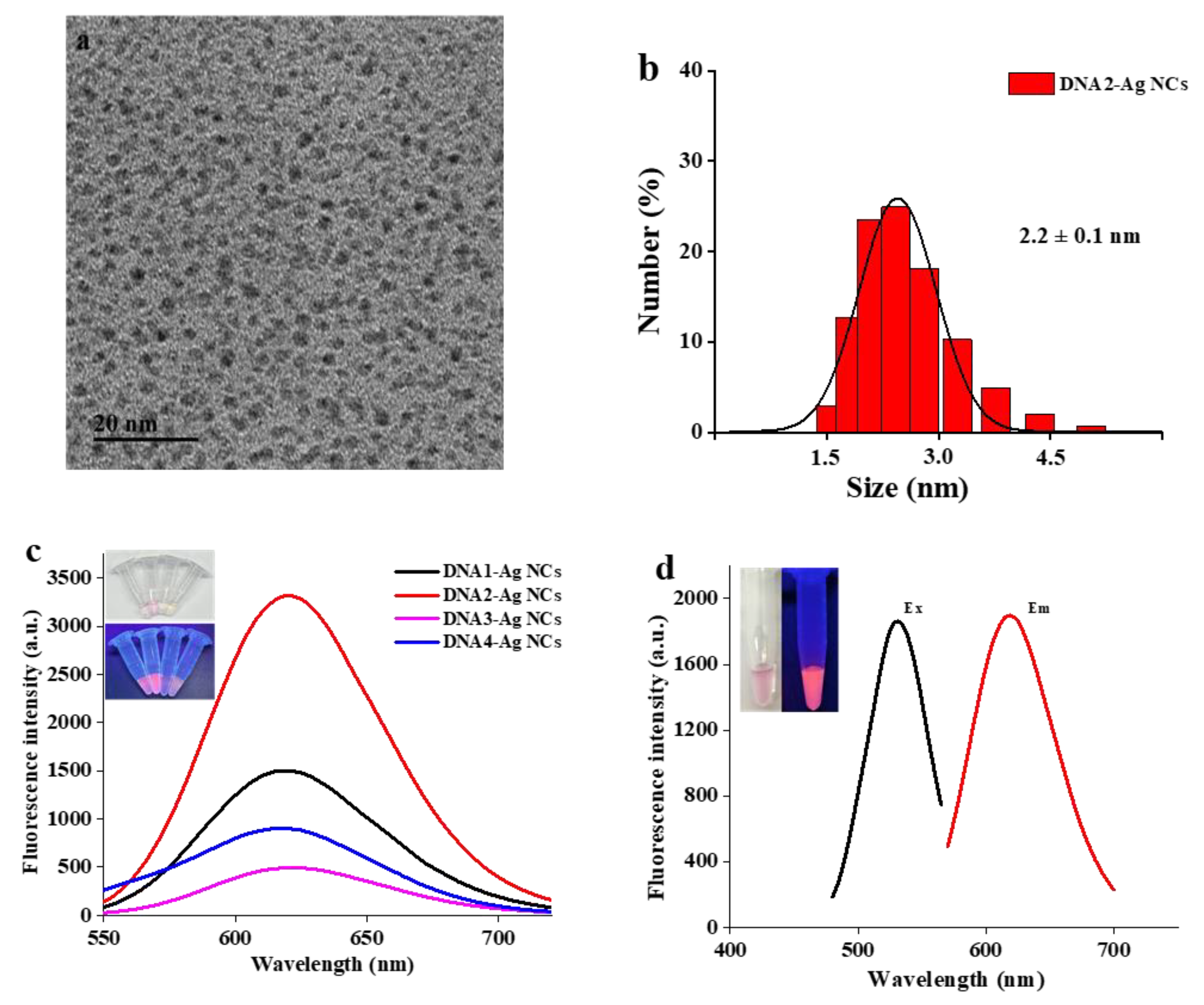
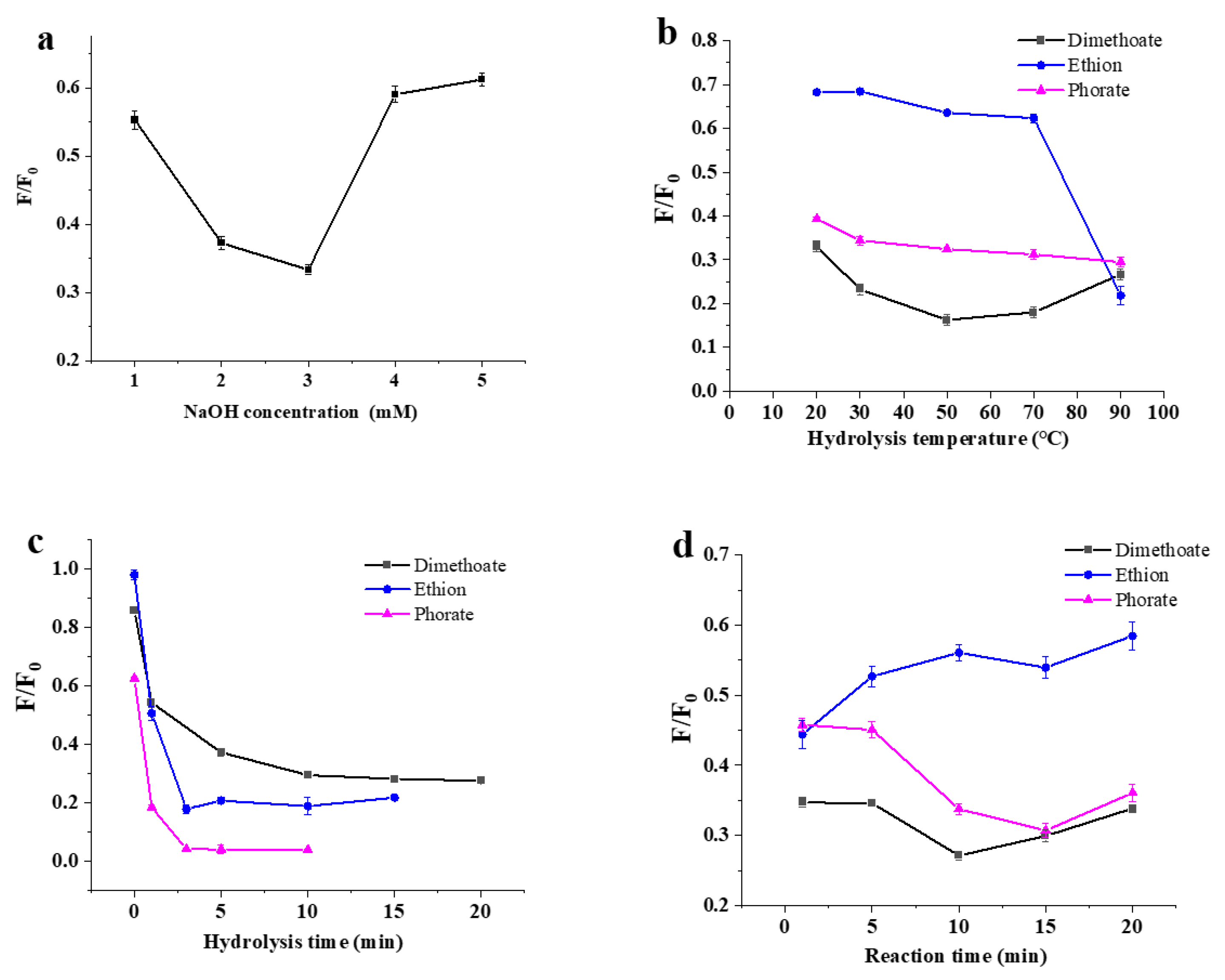
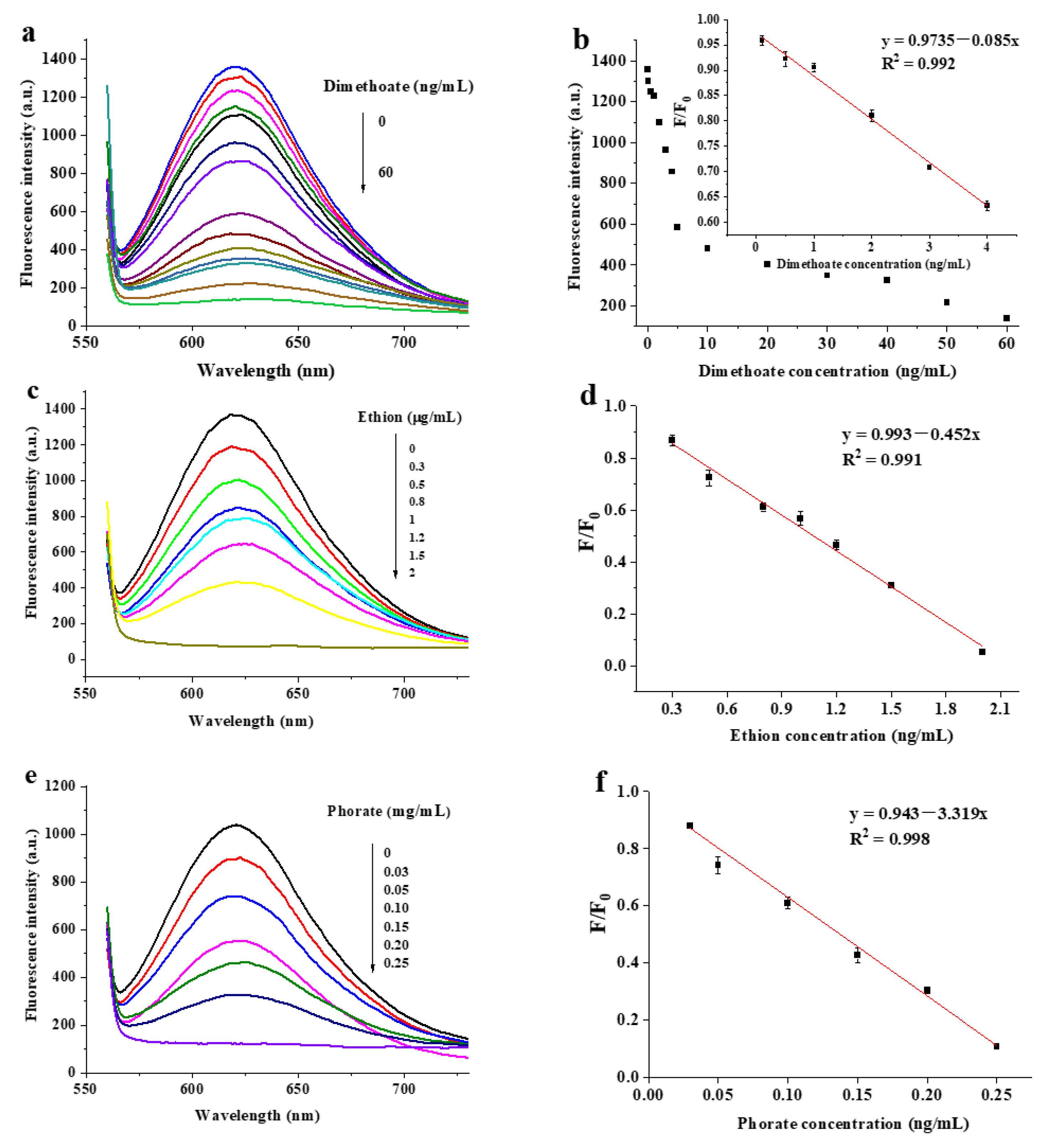
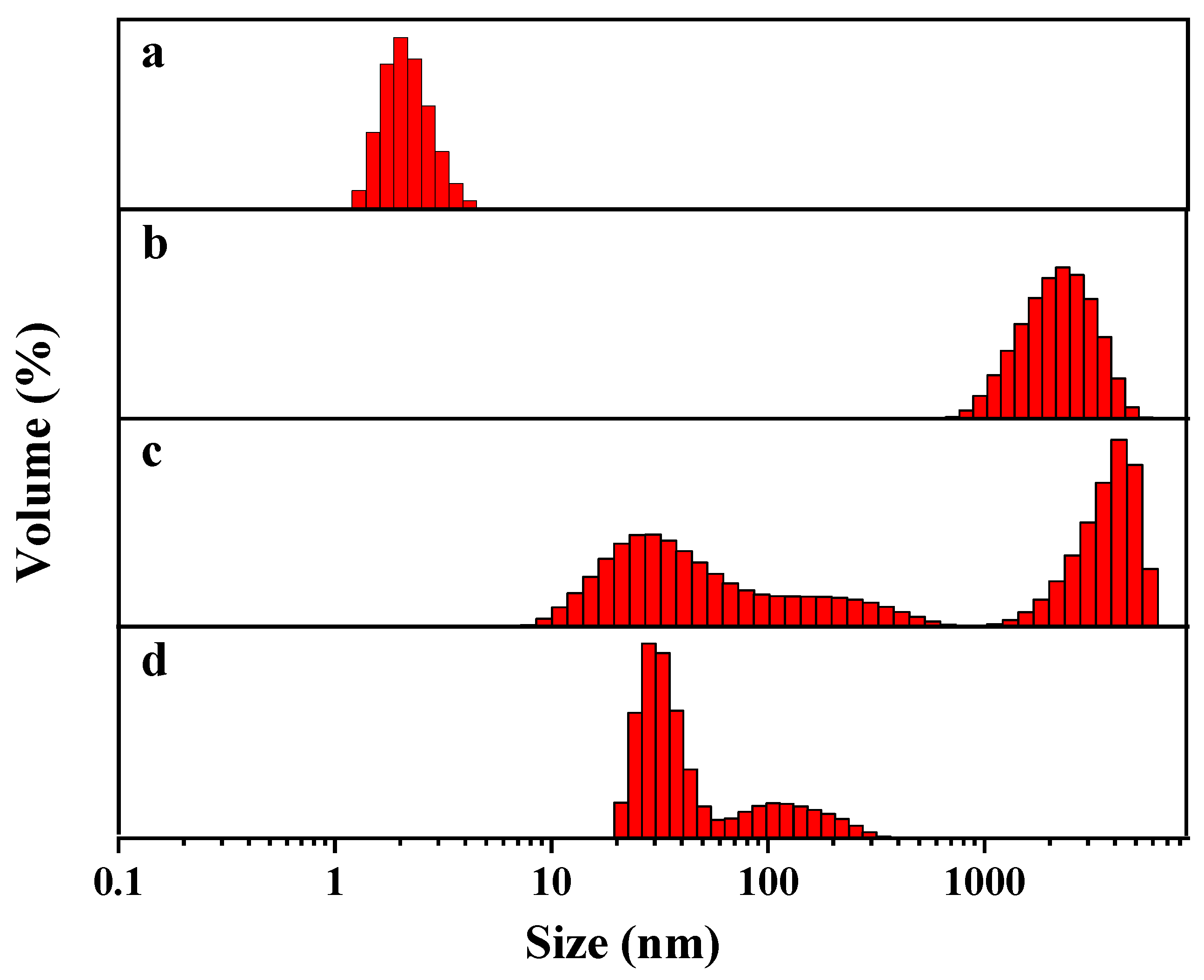

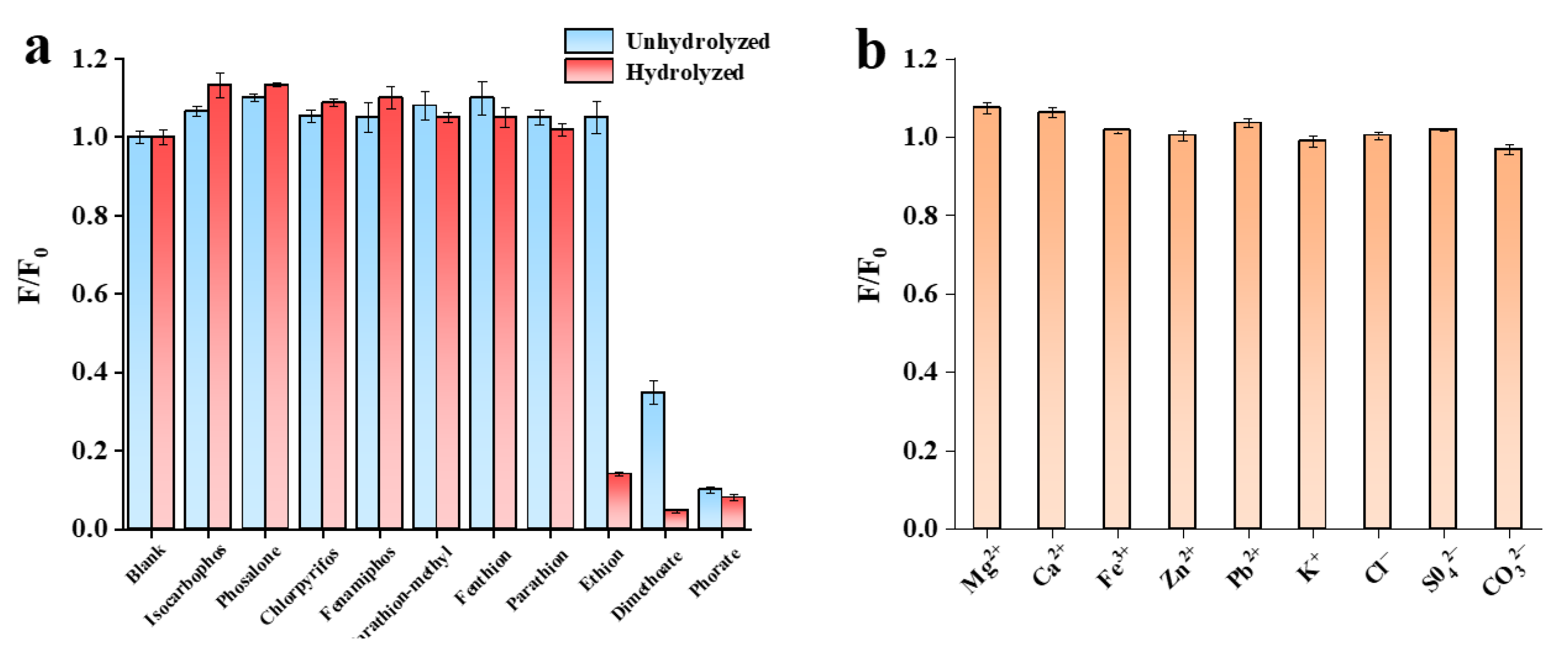
| DNA | Sequence 5′-3′ |
|---|---|
| DNA 1 | ACCCGAACCTGGGCTACCACCCTTAATCCCC |
| DNA 2 | TTACCCGAACCTGGGCTACCACCCTTAATCCCCTT |
| DNA 3 | AAACCCGAACCTGGGCTACCACCCTTAATCCCCAA |
| DNA 4 | GGACCCGAACCTGGGCTACCACCCTTAATCCCCGG |
| Method | Target | Linearity (ng/mL) | LOD (ng/mL) | Reference |
|---|---|---|---|---|
| Colorimetry | Dimethoate | 10–400 | 4.7 | [33] |
| Colorimetry | Dimethoate | 20–160 | 14 | [34] |
| Colorimetry | Phorate | 0.5–5000 | 0.1667 | [35] |
| Gas chromatography | Dimethoate Phorate | 10–1000 10–1000 | 1.8 0.8 | [36] |
| Electrochemistry | Dimethoate | 0.01–300 | 0.0063 | [37] |
| Fluorescence | Dimethoate | 20–3200 | 6 | [38] |
| Fluorescence | Dimethoate | 5–150 | 2.1 | [39] |
| Fluorescence | Dimethoate | 6–200 | 2.24 | [40] |
| Fluorescence | Dimethoate Ethion Phorate | 0.1–4 300–2000 30–250 | 0.05 30 3 | This study |
| Pesticide | Spiked (ng/mL) | Found (ng/mL) | Recovery (%) | RSD (%) |
|---|---|---|---|---|
| Dimethoate | 0.5 | 0.45 | 89 | 4.0 |
| 2.0 | 1.90 | 95 | 2.1 | |
| 4.0 | 4.20 | 105 | 8.0 | |
| Ethion | 500 | 510 | 102 | 7.2 |
| 1000 | 970 | 97 | 3.5 | |
| 1500 | 1650 | 110 | 4.0 | |
| Phorate | 50 | 48 | 96 | 6.2 |
| 200 | 180 | 90 | 4.0 | |
| 400 | 440 | 110 | 9.0 |
Disclaimer/Publisher’s Note: The statements, opinions and data contained in all publications are solely those of the individual author(s) and contributor(s) and not of MDPI and/or the editor(s). MDPI and/or the editor(s) disclaim responsibility for any injury to people or property resulting from any ideas, methods, instructions or products referred to in the content. |
© 2023 by the authors. Licensee MDPI, Basel, Switzerland. This article is an open access article distributed under the terms and conditions of the Creative Commons Attribution (CC BY) license (https://creativecommons.org/licenses/by/4.0/).
Share and Cite
Li, G.; Huang, X.; Peng, C.; Sun, F. Highly Sensitive Fluorescence Detection of Three Organophosphorus Pesticides Based on Highly Bright DNA-Templated Silver Nanoclusters. Biosensors 2023, 13, 520. https://doi.org/10.3390/bios13050520
Li G, Huang X, Peng C, Sun F. Highly Sensitive Fluorescence Detection of Three Organophosphorus Pesticides Based on Highly Bright DNA-Templated Silver Nanoclusters. Biosensors. 2023; 13(5):520. https://doi.org/10.3390/bios13050520
Chicago/Turabian StyleLi, Guowen, Xiufang Huang, Chifang Peng, and Fengxia Sun. 2023. "Highly Sensitive Fluorescence Detection of Three Organophosphorus Pesticides Based on Highly Bright DNA-Templated Silver Nanoclusters" Biosensors 13, no. 5: 520. https://doi.org/10.3390/bios13050520





